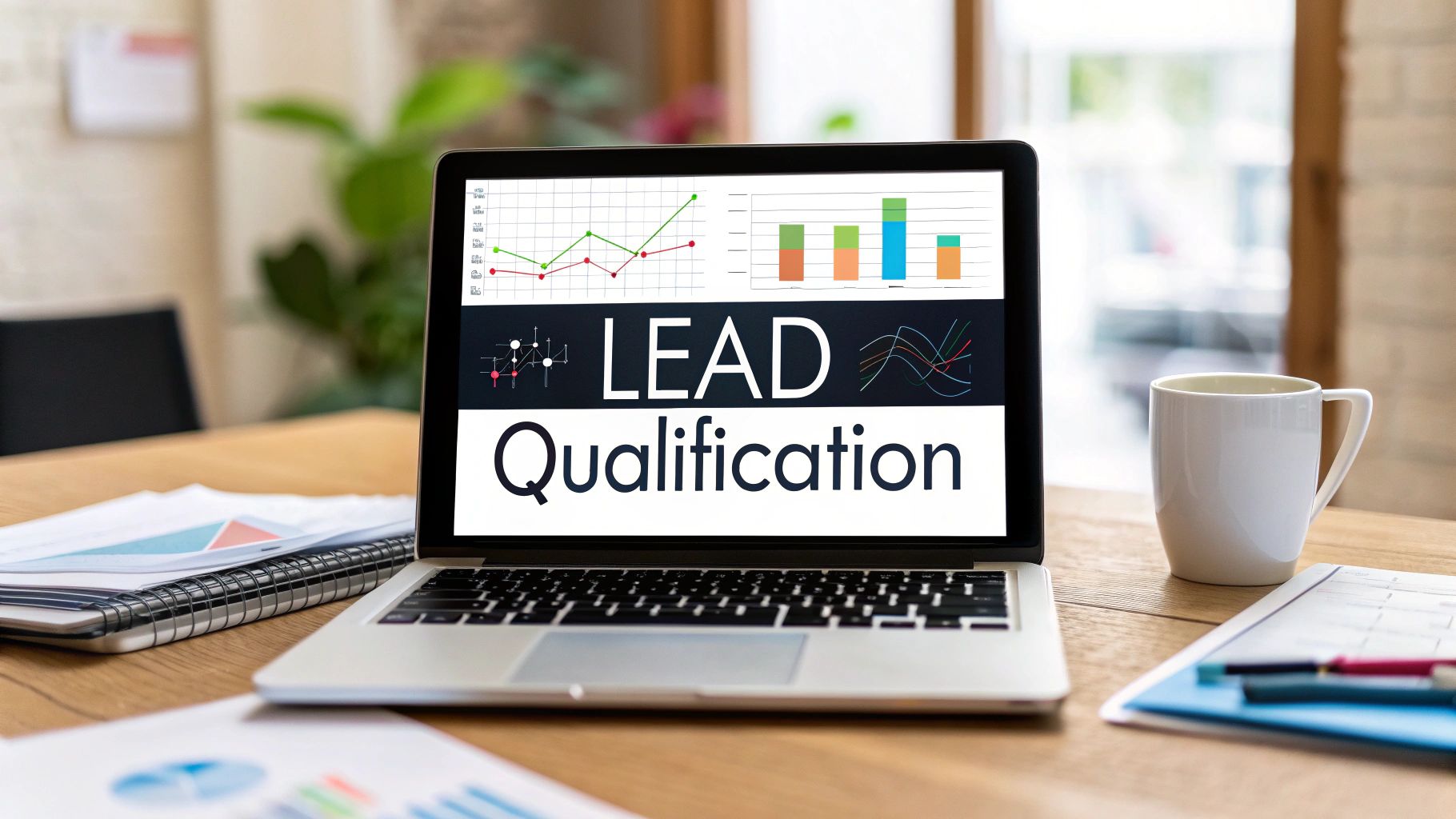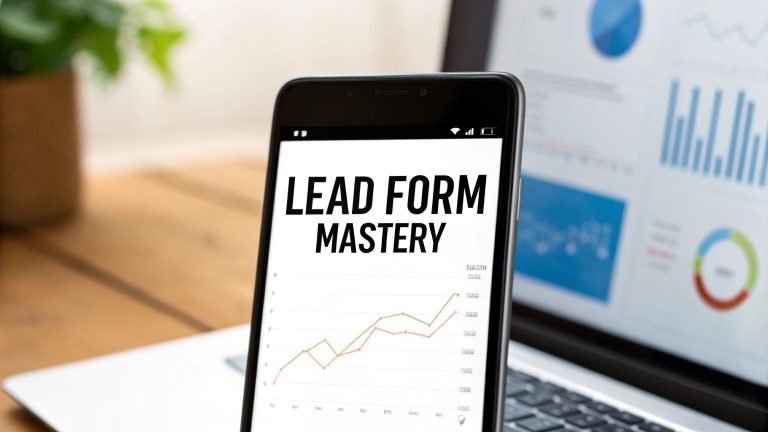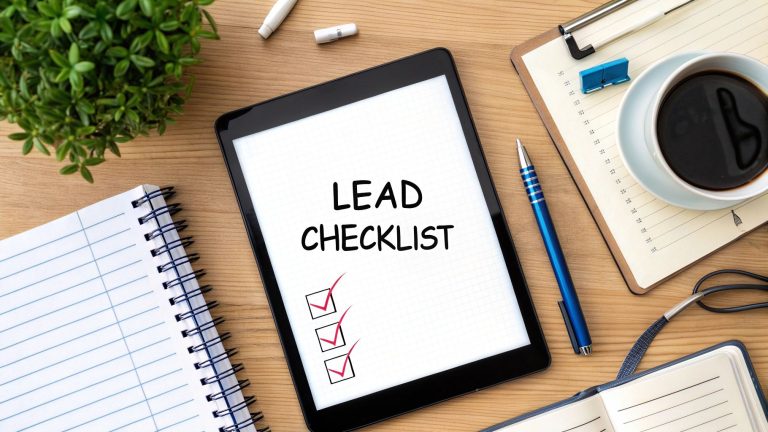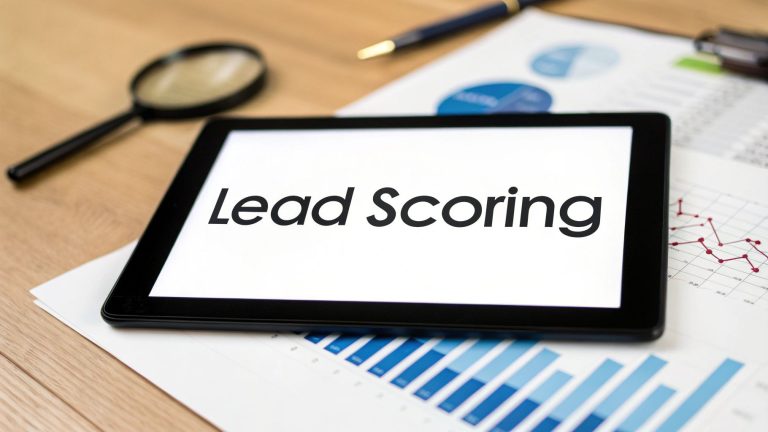Master the Sales Lead Qualification Process Today
A sales lead qualification process is your system for figuring out which prospects are actually worth your sales team's time. It’s all about evaluating leads against a clear set of criteria to separate the hot opportunities from the window shoppers.
This isn't just busywork. A solid qualification process ensures your team focuses its energy on high-value conversations, which directly boosts efficiency and, more importantly, your conversion rates. You stop wasting hours on people who will never buy and start prioritizing those who show real intent.
Why Your Sales Process Is Leaking Revenue

Let's be blunt: a missing or broken lead qualification process is more than just a minor headache. It's a constant drain on your revenue and your team's morale.
When sales reps have no clear way to tell a hot lead from a cold one, they end up treating everyone the same. This "first-come, first-served" approach creates a ton of drag and leads to countless missed opportunities.
Think about it. Your best salesperson might spend half their day chasing down someone who only downloaded an ebook for a school project. Meanwhile, a decision-maker from a perfect-fit company—who just browsed your pricing page for the third time—gets radio silence. By the time your rep finally reaches out, a competitor has already swooped in. This happens all the time, and it's incredibly costly.
The True Cost of Inefficiency
The real damage here goes way beyond a single lost deal. It creates a vicious cycle of inefficiency that burns out your most valuable asset: your sales team.
Reps get demoralized when their pipeline is clogged with contacts who don't have the budget, authority, or a real need for what you sell. They spend far more time digging for gold and far less time actually closing deals, which hammers their performance and your bottom line.
This isn't a rare problem. The data is shocking: only 39% of firms use a structured lead qualification process. As a result, a staggering 55% of all leads are simply neglected. And speed is everything—wait just five minutes to respond, and your chances of qualifying that lead drop by 10x. You can see more of these eye-opening stats on spotio.com.
A flawed qualification process doesn’t just slow you down; it actively pushes your best buyers toward the competition. It's the silent killer of predictable revenue.
A defined process gives you a huge advantage over competitors who are still operating in chaos. To put it in perspective, here’s what the two approaches typically look like side-by-side.
Structured vs. Ad-Hoc Lead Qualification Outcomes
| Metric | Unstructured Process (Common Pitfalls) | Structured Process (Potential Gains) |
|---|---|---|
| Sales Rep Time | Spent chasing low-quality leads; high prospecting effort with low returns. | Focused on pre-vetted, high-intent opportunities; more time spent selling. |
| Conversion Rate | Low and unpredictable; good leads slip through the cracks. | Higher and more consistent; resources are focused on winnable deals. |
| Revenue Forecast | Unreliable and often missed due to a bloated, unqualified pipeline. | Accurate and predictable, based on genuinely qualified opportunities. |
| Team Morale | Low; reps feel frustrated and burned out from unproductive work. | High; reps are empowered, hitting targets, and winning more often. |
| Customer Fit | High churn risk; deals are closed with customers who aren't a good long-term fit. | Low churn risk; sales are made to ideal customers who see long-term value. |
The difference is stark. Moving from an ad-hoc method to a structured one isn't just an operational tweak; it's a fundamental shift in how you generate revenue.
Shifting from Chaos to Clarity
Putting a real sales lead qualification process in place turns that chaotic environment into a well-oiled, predictable revenue engine. Think of it as your first line of defense, filtering out all the noise so your team can focus only on prospects who are genuinely worth their time.
This isn't about creating stuffy, rigid rules. It's about building a smarter system.
With a clear process in place, your team can finally:
- Prioritize with Confidence: Instantly spot and engage the most promising leads based on real data and scoring.
- Improve Forecast Accuracy: Build a pipeline you can actually count on, filled with real opportunities instead of a long list of dead-end contacts.
- Boost Team Morale: Give your reps the tools they need to have meaningful conversations and close deals they can actually win, which crushes burnout.
When you start dedicating the right resources to the right prospects at exactly the right time, you plug the leaks in your revenue and build a solid foundation for real, sustainable growth.
Building Your Lead Qualification Framework
A rock-solid sales lead qualification process doesn’t just happen—it’s built with purpose. This is where you get your hands dirty, turning those high-level business goals into a repeatable system with clear, actionable rules for your team. And it all starts with your Ideal Customer Profile (ICP).
Think of your ICP as the blueprint for your perfect customer. It’s way more than just basic demographics; it digs into the specific DNA of the companies that get the most out of what you sell. The first move? Get your sales and marketing folks in a room and hash out these core traits.
Defining Key Qualification Criteria
Your ICP is the foundation, but the criteria are the actual building blocks you'll use to size up every new lead. These data points generally fall into two buckets: who they are (firmographics) and what they do (behavioral). You need both to get the full picture.
-
Firmographic Data: This is the "who." It’s the hard data about their company you can usually snag from enrichment tools or the info they give you on a form. We're talking about things like company size, industry, where they're located, and annual revenue.
-
Behavioral Data: This is the "what" and "why" of their interest. It tracks how a lead is engaging with you, which is a massive signal of their intent. This could be anything from the pages they visit on your website, the guides they download, or how they interact with your emails.
A lead's behavior is often a far better predictor of their readiness to buy than their profile alone. Someone who perfectly fits your ICP but hasn't lifted a finger is ice cold. But that lead who almost fits your profile but has hit your pricing page three times this week? That's a hot prospect you need to call. Now.
For instance, a great rule to set up in LeadSavvy Pro might flag any lead from the "SaaS" or "E-commerce" industry with over 50 employees that has also downloaded a case study and visited the pricing page. It's this powerful mix of firmographic and behavioral data that makes your qualification process click.
This infographic breaks down how all the pieces fit together.

As you can see, it’s all about filtering the raw, inbound leads through your specific criteria. The goal is to hand your sales team a curated list of genuinely qualified opportunities, not just a mountain of contacts.
Translating Criteria into Actionable Rules
Once you know what to look for, the next step is building those criteria right into your system. This is where you create the automated rules that will do all the heavy lifting for you. You're basically teaching your system to think like your top salesperson.
The beauty of a tool like LeadSavvy Pro is that you can build these rules without writing a single line of code. You just define the conditions that signal a great lead.

This screenshot shows just how easy it is to combine multiple conditions—like industry, company size, and specific actions—to create a super-targeted rule that pinpoints your best leads automatically.
This is a world away from manual qualification, where reps burn hours digging through a CRM just to find these same insights. By building a framework, you create a consistent, reliable filter that holds every single lead to the same high standard. If you want to make sure you're not missing anything, our complete lead qualification checklist is a great resource to have handy.
The goal isn't to create a tangled mess of rules. Start simple. Pick a few high-impact criteria from your ICP and expand from there. What you'll end up with is a system that brings incredible clarity and focus, freeing up your sales team to invest their time where it really counts.
Implementing a Dynamic Lead Scoring Model

Okay, you've got your basic framework down. Now it's time to get a bit more sophisticated and really figure out who's ready to buy. This is where a dynamic lead scoring model comes into play, turning your qualification process from a simple checklist into a system that actually understands real-time buying signals.
Let’s be honest: not all lead actions are created equal. Someone signing up for your newsletter is one thing. Someone downloading a technical whitepaper or hitting your pricing page? That’s a whole different level of interest. Your scoring model has to capture that difference.
Assigning Values to Actions and Attributes
The whole point of lead scoring is to put a number on a lead's engagement and how well they fit your ideal customer profile. It gives your sales team a clear, data-backed reason to prioritize one lead over another. Think of it as a credit score for sales readiness.
You can build a surprisingly powerful model by assigning points based on the value of each action. Here’s a simple way I like to break it down:
-
Low-Intent Actions (1-5 points): These are your top-of-funnel, "just browsing" activities.
- Newsletter signup: +5 points
- Blog post view: +1 point
-
High-Intent Actions (10-25 points): These actions scream "I'm interested!" and show a much deeper engagement.
- Downloading a case study or whitepaper: +15 points
- Attending a webinar: +20 points
- Visiting the pricing page: +25 points
Suddenly, the picture becomes crystal clear. A lead with 5 points is just kicking the tires. But a lead who has racked up 65 points is actively in the evaluation stage and probably deserves a call.
Key Takeaway: A good lead scoring model is alive. It shouldn't just reward positive actions. It needs to account for red flags and inactivity to give you an accurate, up-to-the-minute snapshot of a lead's interest.
Don't forget to use negative scoring. This is a non-negotiable for keeping your pipeline clean and focused. For instance, you could subtract points if a lead visits your careers page (-10 points) or goes quiet for a while (-5 points per month of inactivity).
Setting Your MQL to SQL Thresholds
Once your scoring system is live, you can finally set clear, automated rules for when a lead gets handed off from marketing to sales. This is the moment a Marketing Qualified Lead (MQL) becomes a Sales Qualified Lead (SQL), and it ensures your sales team only spends time on genuinely hot leads.
For example, you could decide that any lead hitting 50 points is an MQL, but the magic number for an SQL handoff is 80 points. When a lead hits that 80-point mark, LeadSavvy Pro can automatically ping a sales rep and assign the lead for immediate follow-up.
This isn't just a hunch; it's backed by industry data. An insightful lead generation report found that for nearly 75% of companies, how often a lead engages is the top scoring factor. Most leads (40%) land in that 41-60 point "sweet spot"—perfect for nurturing. But the top 10% blow past 80 points, signaling they're high-priority and ready to talk.
By putting a scoring model in place, you eliminate the guesswork. Your team stops wondering who to call next and starts having meaningful conversations with people who have already shown you, through their actions, that they're ready.
Automating Workflows for Your Sales Team

Okay, so you've got your lead scoring model dialed in. Now it's time for the real magic: taking that intelligence and putting it on autopilot. This is where you stop relying on your team’s memory and start building automated workflows that do the heavy lifting for you.
Let's be honest, the biggest drain on a sales team isn't talking to prospects—it's the mountain of manual, repetitive tasks that pile up. Think about all the time wasted checking for new high-scoring leads or manually assigning the next hot prospect. Automation crushes that wasted time.
The goal here is simple: create a system where your best leads get attention instantly. This doesn't just make your team more efficient; it creates a killer first impression for the prospect and dramatically boosts your chances of connecting while their interest is red-hot.
Building Practical Automation Rules
Getting these workflows running in a tool like LeadSavvy Pro is a lot more straightforward than you might think. It all boils down to simple "if/then" logic. You define a trigger (the "if") and then tell the system what action to take (the "then").
This is how you transform your lead qualification from a manual chore into a dynamic, self-running machine.
For instance, you can set up a rule that sends an instant Slack alert to a sales rep the second a lead's score crosses your 80-point SQL threshold. That single workflow ensures no hot lead ever goes cold just because it was sitting unnoticed in the CRM. You can find more hands-on advice in our guide to marketing automation implementation.
This one change directly solves a massive industry headache. Research shows that a staggering 44% of sales reps feel they're too swamped to follow up with every single lead. Automation closes that gap, making sure every valuable opportunity gets the attention it deserves. And with only about 25% of sales teams using these kinds of tools, there's a huge opportunity to get ahead. You can dig into more of these lead generation statistics on explodingtopics.com.
An automated workflow doesn't just save time; it manufactures perfect timing. It connects your best reps with your best leads at the exact moment their interest is highest, which is a powerful advantage.
Example Automation Rules for Lead Management
To make this more concrete, I've put together a few examples of the kinds of rules you can build to bring your sales process to life. Think of these as a starting point.
| Trigger (IF) | Condition | Action (THEN) |
|---|---|---|
| Lead Score | Reaches 80+ points | Automatically assign the lead to the next available sales rep in a round-robin sequence and create a task in the CRM. |
| Page Visit | Lead visits the "Contact Us" or "Demo Request" page | Immediately send a high-priority notification to the lead owner's Slack channel for instant follow-up. |
| Form Submission | Lead downloads the "Pricing & Packaging Guide" PDF | Trigger a personalized 3-part email nurture sequence that highlights key features and customer testimonials. |
| Lead Status | Lead is marked as "Unresponsive" after 3 contact attempts | Move the lead into a long-term automated nurturing campaign and reduce their lead score by 20 points. |
These simple but powerful rules are what keep your pipeline moving and your team focused. Instead of digging through lists to find opportunities, they can pour all their energy into what they do best: building relationships and closing deals. Automation creates the space for that to happen.
How to Continuously Refine Your Process
Getting your sales lead qualification process up and running is a huge win. But here's something most people miss: it's never really "done." A great process is a living system that has to evolve with your business and your market.
Think of it like tuning a guitar. The initial setup gets you playing in the right key, but you have to keep making small adjustments to stay perfectly in tune. This is where you go from a good process to a great one that consistently drives revenue.
The real magic happens when you create a tight, data-driven feedback loop between your sales and marketing teams. When both sides are looking at the same numbers and sharing what’s actually happening on the ground, your qualification gets sharper, lead quality skyrockets, and your pipeline becomes way more predictable.
Creating Your Data Feedback Loop
To start refining, you need to track the right things. Forget vanity metrics—we're focused on the key performance indicators (KPIs) that tell you if your qualification efforts are actually working.
Your dashboard in LeadSavvy Pro is your command center for this. Here are the metrics I always keep a close eye on:
- MQL-to-SQL Conversion Rate: This is the big one. It shows what percentage of marketing-qualified leads your sales team actually accepts as real opportunities. If this number is low, it’s a red flag that your MQL definition is probably too broad.
- Lead Source Effectiveness: Not all channels are created equal. You need to know which sources—whether it's organic search, a specific ad campaign, or a webinar—are delivering leads that turn into customers. Stop wasting money on channels that don't perform.
- Average Time-to-Qualification: How long does it take for a brand-new lead to become sales-qualified? The shorter, the better. A fast time means your automation and scoring are working together to surface hot leads before they go cold.
- SQL-to-Close Rate: Of the leads sales accepts, how many end up signing on the dotted line? This metric connects your lead qualification model directly to business impact and revenue.
I see this all the time: a team builds a qualification process and then doesn't touch it for a year. The market moves way too fast for that. You should be reviewing and tweaking your process at least once a quarter to stay effective.
Running Effective Review Meetings
Data tells you what is happening, but you need people to understand why. The best way to dial in your process is to get marketing and sales in the same room (virtual or physical) on a regular basis.
Put a recurring monthly or bi-monthly meeting on the calendar dedicated only to lead quality and pipeline health. Keep the agenda simple and focused:
- Review the KPIs Together. Pull up the dashboard and look at the core metrics. Where are the bottlenecks? Is the MQL-to-SQL rate trending up or down?
- Talk About Real Leads. Ask the sales team to share stories. What did a few recent high-quality leads that closed have in common? What about the ones that looked good but fizzled out? The devil is always in the details.
- Challenge Your Assumptions. Based on those stories, re-examine your scoring. Was that webinar that gives a lead 20 points really a strong buying signal? Or are you finding that leads who download a specific case study are the ones most likely to close?
These meetings aren't for pointing fingers; they're for fine-tuning the engine. They create a culture of shared ownership.
Based on these conversations, you can jump back into your system and make adjustments. Maybe you change a few scoring values, add a new behavioral trigger, or tweak your ICP criteria. This is the cycle of continuous improvement that separates the pros from the amateurs.
Common Questions About Lead Qualification
Even with the best-laid plans, a few questions always pop up when you're getting a new lead qualification process off the ground. It’s completely normal. Let's walk through some of the most common hurdles we see teams face when they’re making this change.
It’s easy to feel overwhelmed, and the biggest question is usually, "Where do I even begin?" The key is to keep it simple at first. Don't try to build the perfect, all-encompassing system on day one. Instead, look at who your best customers are right now and build your Ideal Customer Profile (ICP) from there.
Once you have a solid ICP, just pick two or three high-impact criteria to start with. This gives you a solid foundation to build upon later.
How Long Should This Take?
This is a big one. Everyone wants to know, "How long until we see results?" While it varies from business to business, you'll likely notice initial improvements—like a cleaner pipeline and a more focused team—within the first month.
A fully optimized process, however, takes time to get right. Consider that a staggering 67% of lost sales are chalked up to poor qualification. That stat alone shows why it's so important not to rush this. Plan to review and adjust your scoring and criteria every quarter based on what's actually closing. This is a long-term strategy, not a quick fix.
Is My Company Too Small for This?
I hear this myth all the time: lead qualification is only for big companies with massive sales teams. Honestly, it's the other way around.
Smaller teams have to be scrappy with their resources. That makes it even more critical to focus your limited time on prospects who actually have a real shot at converting. A simple qualification framework stops your small (but mighty) sales team from burning precious hours on dead-end leads.
Even a basic checklist is worlds better than having no system at all. It can immediately boost your team's efficiency and stop your best opportunities from falling through the cracks.
What’s the Difference Between MQL and SQL?
This is a classic point of confusion, but getting it right is fundamental for getting your marketing and sales teams on the same page. If you want to go deeper, we have a complete guide that breaks down what lead qualification is in much more detail.
Here’s the simple version:
-
Marketing Qualified Lead (MQL): Think of an MQL as someone who raised their hand. They’ve engaged with your marketing—maybe they downloaded an ebook or attended a webinar. They're interested, but they're not necessarily ready to buy right now. Marketing has flagged them as being more likely to become a customer than other leads.
-
Sales Qualified Lead (SQL): An SQL is a lead that sales has vetted and accepted as a genuine opportunity. They've been checked against stricter criteria, like the BANT framework (Budget, Authority, Need, and Timing), and are ready for a direct conversation with a salesperson.
Ready to stop wasting time and start focusing on deals you can actually win? LeadSavvy Pro automates your entire sales lead qualification process, from scoring and routing to instant notifications. See how much more efficient your team can be. Start your free plan today at https://leadsavvy.pro.







